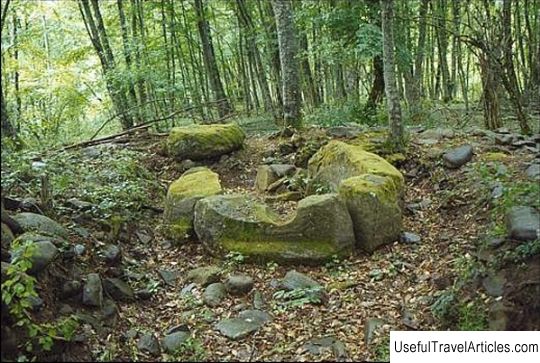Silbury Hill UK
Rating: 8,5/10 ( votes)  Silbury Hill is a 40-meter high mound artificially created from chalk soils, which is located next to the Avebury megalithic monument in Wiltshire, UK. Included in the UNESCO World Heritage List. Silbury Hill is one of the tallest prehistoric mounds in the world and the tallest in Europe (about 40 meters). The shape of the mound is conical, resembling a pyramid. At the base, it has a diameter of 167 m, and towards the upper flat cut it narrows to 30 m in diameter. Presumably, the construction of the mound began around 2750 BC. AD, according to another popular belief, around 2500 BC. The first archaeological excavations at the site of the present mound were carried out back in 1760 by miners under the leadership of the Duke of Northumberland. The next ones happened almost a hundred years later, in 1849. Then the antiquary D. Mirweather dug a tunnel into the hill to its base. Research continued in 1867 and 1886. and continue to this day. The first comparatively accurate descriptions were created by the scientists D. Aubrey and W. Glass. Unusual is the fact that not a single burial was found inside the mound. Active excavations and tunnels inside Silbury Hill led to a significant collapse of the soil in 2000. As a result, the historical monument was restored at great expense by the government, and all internal passages were filled up. At the same time, the excavations nevertheless made it possible to establish a system for the construction of the mound, which for its time was distinguished by high manufacturability. So, the pyramid was built on the basis of a special frame in the form of hollow drums inside, which were then filled with chalk soils. Research continued in 1867 and 1886. and continue to this day. The first comparatively accurate descriptions were created by the scientists D. Aubrey and W. Glass. Unusual is the fact that not a single burial was found inside the mound. Active excavations and tunnels inside Silbury Hill led to a significant collapse of the soil in 2000. As a result, the historical monument was restored at great expense by the government, and all internal passages were filled up. At the same time, the excavations nevertheless made it possible to establish a system for the construction of the mound, which for its time was highly technological. So, the pyramid was built on the basis of a special frame in the form of hollow drums inside, which were then filled with chalk soils. Research continued in 1867 and 1886. and continue to this day. The first comparatively accurate descriptions were created by the scientists D. Aubrey and W. Glass. Unusual is the fact that not a single burial was found inside the mound. Active excavations and tunnels inside Silbury Hill led to a significant collapse of the soil in 2000. As a result, the historical monument was restored at great expense by the government, and all internal passages were filled up. At the same time, the excavations nevertheless made it possible to establish a system for the construction of the mound, which for its time was highly technological. So, the pyramid was built on the basis of a special frame in the form of hollow drums inside, which were then filled with chalk soils. that not a single burial was found inside the mound. Active excavations and tunnels inside Silbury Hill led to a significant collapse of the soil in 2000. As a result, the historical monument was restored at great expense by the government, and all internal passages were filled up. At the same time, the excavations nevertheless made it possible to establish a system for the construction of the mound, which for its time was highly technological. So, the pyramid was built on the basis of a special frame in the form of hollow drums inside, which were then filled with chalk soils. that not a single burial was found inside the mound. Active excavations and tunnels inside Silbury Hill led to a significant collapse of the soil in 2000. As a result, the historical monument was restored at great expense by the government, and all internal passages were filled up. At the same time, the excavations nevertheless made it possible to establish a system for the construction of the mound, which for its time was highly technological. So, the pyramid was built on the basis of a special frame in the form of hollow drums inside, which were then filled with chalk soils. At the same time, the excavations nevertheless made it possible to establish a system for the construction of the mound, which for its time was highly technological. So, the pyramid was built on the basis of a special frame in the form of hollow drums inside, which were then filled with chalk soils. At the same time, the excavations nevertheless made it possible to establish a system for the construction of the mound, which for its time was highly technological. So, the pyramid was built on the basis of a special frame in the form of hollow drums inside, which were then filled with chalk soils. Silbury Hill is a 40-meter high mound artificially created from chalk soils, which is located next to the Avebury megalithic monument in Wiltshire, UK. Included in the UNESCO World Heritage List. Silbury Hill is one of the tallest prehistoric mounds in the world and the tallest in Europe (about 40 meters). The shape of the mound is conical, resembling a pyramid. At the base, it has a diameter of 167 m, and towards the upper flat cut it narrows to 30 m in diameter. Presumably, the construction of the mound began around 2750 BC. AD, according to another popular belief, around 2500 BC. The first archaeological excavations at the site of the present mound were carried out back in 1760 by miners under the leadership of the Duke of Northumberland. The next ones happened almost a hundred years later, in 1849. Then the antiquary D. Mirweather dug a tunnel into the hill to its base. Research continued in 1867 and 1886. and continue to this day. The first comparatively accurate descriptions were created by the scientists D. Aubrey and W. Glass. Unusual is the fact that not a single burial was found inside the mound. Active excavations and tunnels inside Silbury Hill led to a significant collapse of the soil in 2000. As a result, the historical monument was restored at great expense by the government, and all internal passages were filled up. At the same time, the excavations nevertheless made it possible to establish a system for the construction of the mound, which for its time was distinguished by high manufacturability. So, the pyramid was built on the basis of a special frame in the form of hollow drums inside, which were then filled with chalk soils. Research continued in 1867 and 1886. and continue to this day. The first comparatively accurate descriptions were created by the scientists D. Aubrey and W. Glass. Unusual is the fact that not a single burial was found inside the mound. Active excavations and tunnels inside Silbury Hill led to a significant collapse of the soil in 2000. As a result, the historical monument was restored at great expense by the government, and all internal passages were filled up. At the same time, the excavations nevertheless made it possible to establish a system for the construction of the mound, which for its time was highly technological. So, the pyramid was built on the basis of a special frame in the form of hollow drums inside, which were then filled with chalk soils. Research continued in 1867 and 1886. and continue to this day. The first comparatively accurate descriptions were created by the scientists D. Aubrey and W. Glass. Unusual is the fact that not a single burial was found inside the mound. Active excavations and tunnels inside Silbury Hill led to a significant collapse of the soil in 2000. As a result, the historical monument was restored at great expense by the government, and all internal passages were filled up. At the same time, the excavations nevertheless made it possible to establish a system for the construction of the mound, which for its time was highly technological. So, the pyramid was built on the basis of a special frame in the form of hollow drums inside, which were then filled with chalk soils. that not a single burial was found inside the mound. Active excavations and tunnels inside Silbury Hill led to a significant collapse of the soil in 2000. As a result, the historical monument was restored at great expense by the government, and all internal passages were filled up. At the same time, the excavations nevertheless made it possible to establish a system for the construction of the mound, which for its time was highly technological. So, the pyramid was built on the basis of a special frame in the form of hollow drums inside, which were then filled with chalk soils. that not a single burial was found inside the mound. Active excavations and tunnels inside Silbury Hill led to a significant collapse of the soil in 2000. As a result, the historical monument was restored at great expense by the government, and all internal passages were filled up. At the same time, the excavations nevertheless made it possible to establish a system for the construction of the mound, which for its time was highly technological. So, the pyramid was built on the basis of a special frame in the form of hollow drums inside, which were then filled with chalk soils. At the same time, the excavations nevertheless made it possible to establish a system for the construction of the mound, which for its time was highly technological. So, the pyramid was built on the basis of a special frame in the form of hollow drums inside, which were then filled with chalk soils. At the same time, the excavations nevertheless made it possible to establish a system for the construction of the mound, which for its time was highly technological. So, the pyramid was built on the basis of a special frame in the form of hollow drums inside, which were then filled with chalk soils.We also recommend reading Stonehenge UK Topic: Silbury Hill UK. |




